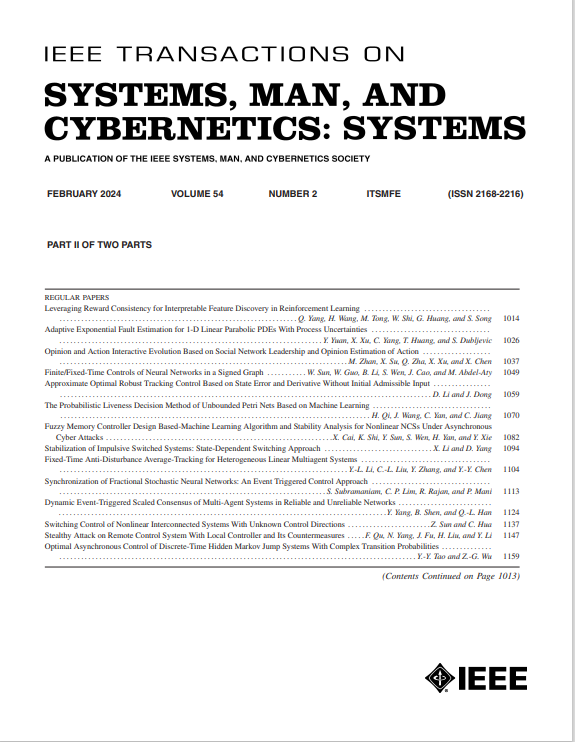一种新型四旋翼飞机分层分布式鲁棒编队控制策略
IF 8.7
1区 计算机科学
Q1 AUTOMATION & CONTROL SYSTEMS
IEEE Transactions on Systems Man Cybernetics-Systems
Pub Date : 2025-07-29
DOI:10.1109/TSMC.2025.3585704
引用次数: 0
摘要
多架四旋翼飞机系统在危险环境下执行复杂任务具有显著优势,但对于存在外部干扰或内部模型不确定性的编队来说,仍然具有挑战性。本文建立了多架四旋翼飞行器的分层分布式鲁棒编队策略,其中分别在不同层控制轨迹跟踪和姿态形成。提出了一种上轨迹跟踪控制器,为下姿态形成控制器生成期望位置,并分别设计了带扰动观测器的双电平自适应终端滑模控制器。在下一控制层,速度控制部分产生期望速度,保证四旋翼飞行器在保持一定编队形状的情况下跟踪期望位置,而加速度控制部分负责驱动各四旋翼飞行器的实际速度达到期望速度。稳定性分析表明,在未知扰动有界的情况下,适当选择各层的时间常数,可以实现规定的形状。与已有结果相比,该策略可以在不同层实现多个复杂任务,提高编队精度,实现干扰抑制。通过Gazebo仿真和实际实验验证了该方法的有效性。本文章由计算机程序翻译,如有差异,请以英文原文为准。
A Novel Hierarchical Distributed Robust Formation Control Strategy for Multiple Quadrotor Aircrafts
Multiple quadrotor aircraft system has significant advantages for performing complex tasks in dangerous environments, but it is still challenging for formation with external disturbance or internal model uncertainty. This article establishes a hierarchical distributed robust formation strategy for multiple quadrotor aircrafts, in which trajectory tracking and attitude formation are, respectively, controlled in different layers. An upper trajectory tracking controller is proposed to generate desired position for lower anti-disturbance attitude formation controller, where a bi-level adaptive terminal sliding mode controller with disturbance observers are, respectively, designed. In lower control layer, the desired velocity is generated by velocity control part to ensure quadrotor aircraft to track desired position while maintaining certain formation shape, whereas the acceleration control part is responsible for driving actual velocity of each quadrotor aircraft to desired velocity. Stability analysis shows that the prescribed formation can be realized if unknown disturbance is bounded and time constants in different layers are selected appropriately. Compared with existing results, the proposed strategy enables multiple complex tasks to be realized in different layers to improve formation accuracy and achieve interference suppression. The effectiveness is verified through both Gazebo simulation and actual experiment.
求助全文
通过发布文献求助,成功后即可免费获取论文全文。
去求助
来源期刊

IEEE Transactions on Systems Man Cybernetics-Systems
AUTOMATION & CONTROL SYSTEMS-COMPUTER SCIENCE, CYBERNETICS
CiteScore
18.50
自引率
11.50%
发文量
812
审稿时长
6 months
期刊介绍:
The IEEE Transactions on Systems, Man, and Cybernetics: Systems encompasses the fields of systems engineering, covering issue formulation, analysis, and modeling throughout the systems engineering lifecycle phases. It addresses decision-making, issue interpretation, systems management, processes, and various methods such as optimization, modeling, and simulation in the development and deployment of large systems.
 求助内容:
求助内容: 应助结果提醒方式:
应助结果提醒方式:


